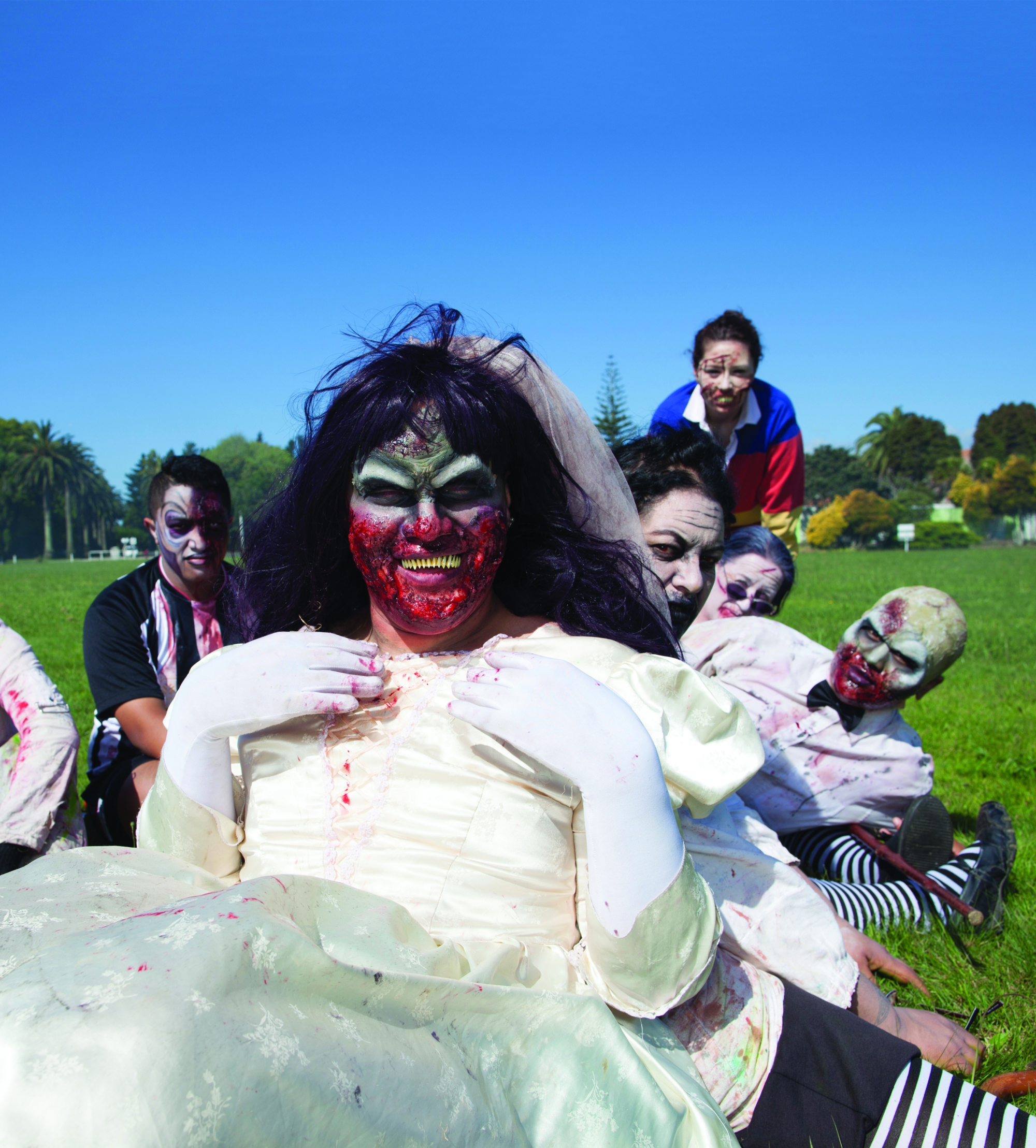Berlin-born, New Zealand–raised writer/director Florian Habicht isn’t one for following traditional narratives. An artist by training and inspired by the Swinging Sixties photography of his famous father, Frank, he’s a self-taught filmmaker who revels in experimentation born of a sprightly fascination with getting out and just doing.
I meet Habicht in the bustling foyer of a Spring Street hotel during the Melbourne International Film Festival; his gangly appearance, eccentric fashion and mullet, capped with a feathered hat, match his reputation. He chuckles as we look out of a floor-to-ceiling window at the arched facade of the Old Treasury Building. ‘I always had my own camera,’ he tells me. ‘I loved to get out and shoot something, and then try and make sense of it – get some funding to complete it and write it more in the edit.’ It’s unsurprising, then, that his latest documentary, Spookers (2017), bears little resemblance to the film he originally pitched in funding applications.
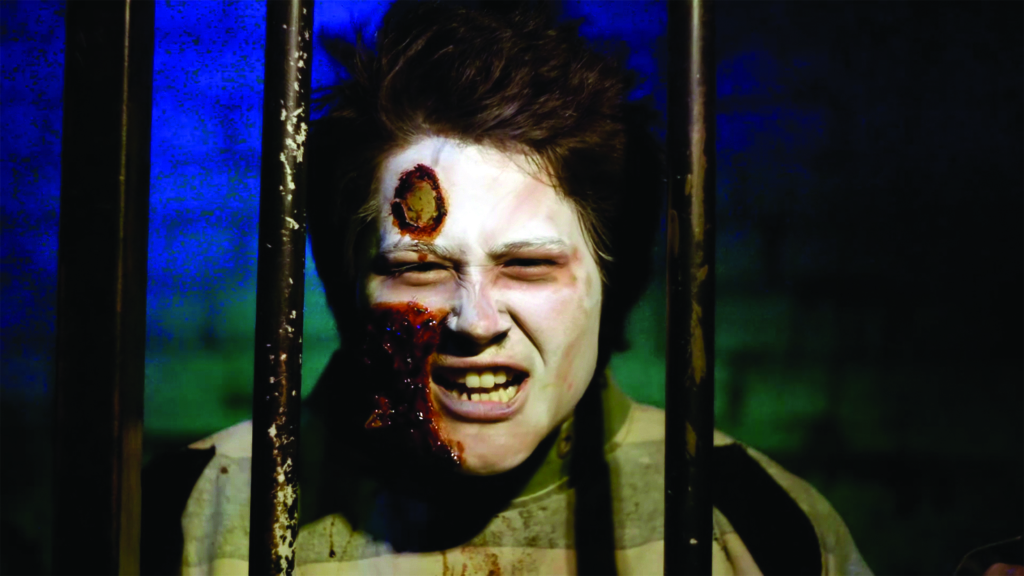
Initially envisioned as a profile of kooky former sheep farmers Beth and Andy Watson and their abandoned plans to expand their eponymous Auckland haunted-house attraction to Melbourne, Spookers arose following a suggestion from Madman Entertainment’s Suzanne Walker, who went on to become a producer on the film. She had heard New Zealand friends raving about the incredible make-up, costumes and performances of the 280 employees who conjure up terrifying clown-zombies, chain-dragging ghosts and blood-gurgling vampires to terrorise foolhardy locals and tourists who visit the sprawling mansion site that once housed Kingseat Psychiatric Hospital. Habicht had never been. Not a fan of the horror genre nor of being terrified witless, he was initially reluctant to pursue Walker’s tip. ‘I don’t need to go somewhere to get chased by someone with a chainsaw,’ he says. ‘I’d rather jump in the ocean to feel alive and get pounded by waves.’
Steeling himself to investigate Spookers, Habicht witnessed not only the incredible talent of the predominantly young crew, but also the enviable camaraderie shared between them. This ‘haunted’ setting seemingly houses a family that comprises individuals who have not otherwise enjoyed much of a support network. Habicht then grasped the real story:
I went there expecting horror but, when I arrived, I saw the actors putting on their make-up and it was more like The Muppet Show – and I found so much joy and happiness. That was what dragged me to the place, and I immediately wanted to make the focus about the young people that worked there, rather than the owners or the journey [of the franchise] to Australia.
Steeling himself to investigate Spookers, Habicht witnessed not only the incredible talent of the predominantly young crew, but also the enviable camaraderie shared between them.
Road less well travelled
Habicht relishes the unusual, the experimental and the inadvertently discovered. Studying at the Elam School of Fine Arts in Auckland, he intended to follow in his father’s photography footsteps, but found himself painting or drawing over his efforts, creating narrative sequences that almost resembled storyboards – which, ironically, Habicht never uses for his cinematic work. Soon, this morphed into dabbling in short films, in which he cast his friends. One in particular, Liebesträume (1997),[1]Liebesträume, Vimeo, 3 March 2012, <https://vimeo.com/37851376>, accessed 7 November 2017. stars Teresa Peters; Habicht acknowledges he had a crush on this woman who would later work as an art director, production designer and actor in his professional films. The unnerving Liebesträume features a rather-Freudian love scene between Peters and Habicht Sr, and, reflecting on his work at the time, the director says:
I was the only one who did narrative because, when I was at art school, ‘narrative’ was a dirty word. But, because my films were funny and love stories, they got a really good response from the audience. And then I got hooked.

This playfulness and willingness to subvert form – working from his gut, rather than a cinematic tradition – has inspired an intriguing career. The score, sound effects and dialogue for his black-and-white debut feature, Woodenhead (2003), were recorded before the action was shot. A menacing, adult take on the already-dark Brothers Grimm fairytales, Woodenhead adopted a similar technique to the eerily sexualised Liebesträume – the actors on screen becoming puppets voiced by other, unseen, performers – and again starred Peters, this time as the Gretel-like figure Plum. The haunting result of this unique, radio-like approach is as bewitching as it is bewildering. As Senses of Cinema critic Philip Matthews describes it:
It is a film of strange, sometimes jarring sensations: a circus-and-fairytale ambience and a Hansel and Gretel-like plotline is subverted by a surreal sense of menace, achieved by a trick as simple as having its kindly-voiced narrator read lines that are more innocent or innocuous than the pictures.[2]Philip Matthews, ‘Fast, Cheap and Out of Control: Three Films from New Zealand’s Digital Video “Revolution”’, Senses of Cinema, issue 31, April 2004, <http://sensesofcinema.com/2004/feature-articles/nz_digital_revolution/>, accessed 7 November 2017.
Habicht’s second drama feature, Love Story (2011) – starring the elven-featured Shauna Goodgold – straddles the boundary between fiction and documentary. It devises a playful romance from the suggestions made by the very real and surprisingly game citizens of New York, whom Habicht happens to encounter on the streets, not always passively.
Having my camera gives me that freedom. I even jumped in a taxi with strangers and interviewed them on camera and got away with it. If I did that without a camera, I’d get arrested or punched in the face.
‘When you put on a mask and make-up, it’s an opportunity to be free, like you can express yourself without fear … when I saw them in make-up, they weren’t afraid to confront people, so it was like me with my camera.’
—Florian Habicht
In his documentary work, Habicht has been equally adventurous. A tourism video morphed into his first feature documentary, Kaikohe Demolition (2004), about the colourful characters of the eponymous far-north town’s mud-sport derby. And, while Habicht cast the late, great theatre actor, director and performance artist Warwick Broadhead as Hugo in Woodenhead, he later chronicled Broadhead’s fascinating and occasionally challenging life in Rubbings from a Live Man (2008). In an interview with Clare O’Leary for NZ on Screen, Habicht recalls their unusual meeting while selling Broadhead a video camera:
He was making a solo show and he was going to film parts of it […] He was kind of flirting with me […] and he bought the camera straightaway without even studying it too closely. I hadn’t seen Warwick’s shows – I mean, I’d heard that he’s this guy who married his house four years ago and had an elaborate ceremony […] As a human being, [I] found him very fascinating because Warwick makes you feel really alive, and he flirts with life and breaks down the barriers between people.[3]Florian Habicht, in Clare O’Leary, ‘Florian Habicht: A Filmmaker with a Light and Quirky Touch…’, NZ On Screen website, 2008, <https://www.nzonscreen.com/interviews/interview-with-florian-habicht/overview>, accessed 7 November 2017.
As if to engender such fascination in his audience, in Rubbings from a Live Man, Habicht tasks Broadhead with starring in a dramatisation of his own life – playing every main character, not just himself.
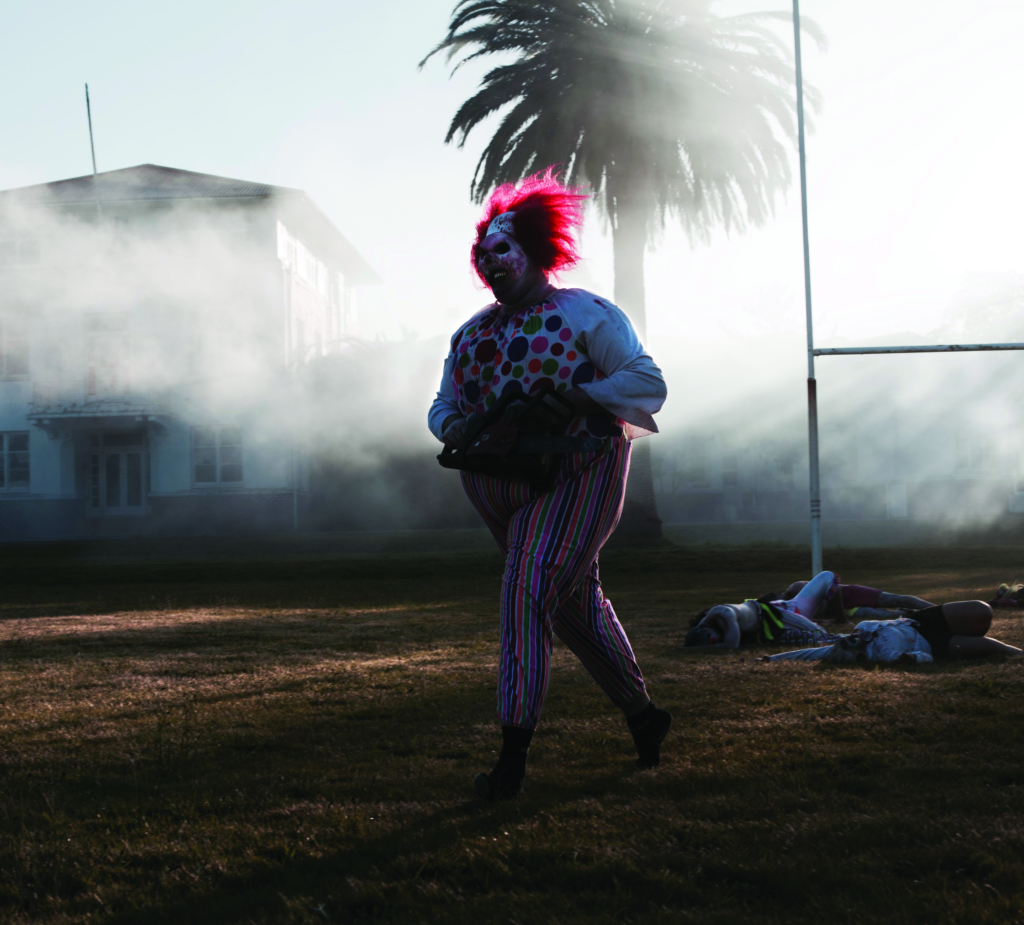
Lifeline offered
Barriers between people are slowly dismantled at Spookers, which celebrates a passion for life in the face of occasionally overwhelming adversity; the same theme lies at the spiritual heart of Habicht’s documentary. The haunted house’s creepily colourful cast have formed an inspiring bond. Between their jokes, their carry-on and their terrifying performances – which see them rewarded annually at Spookers’ own O’Scares ceremony – there’s also a deeply human side to the documentary.
Most of those interviewed on camera have traversed difficult personal terrain on their way to this destination most unusual. Several have experienced mental-health issues, including suicide attempts. Another performer talks about grappling with his HIV-positive diagnosis, and Spookers also deals more broadly with queer themes, including a young man’s coming out and the antagonistic reaction of his family. Throughout all of this, there’s a sense of the Spookers actors having – as Tales of the City author Armistead Maupin would describe it – a ‘logical family’ as opposed to a biological one. ‘It’s amazing: they really support each other through it,’ Habicht says, harking back to the sanctuary he discovered upon arriving at art school. ‘In high school, I didn’t really feel like I fitted in. When I got to art school, all of us were like, “Oh my god, king of the nerds.”’
For Habicht, the camera is a shield. For the subjects of Spookers, it’s the elaborate costumes, self-taught make-up and prosthetic work, easily rivalling that of any big-screen horror movie. As the director explains:
The way I could relate to it myself would be that when you put on a mask and make-up, it’s an opportunity to be free, like you can express yourself without fear. The first people I met were really, really shy […] but then when I saw them in make-up, they weren’t afraid to confront people, so it was like me with my camera.
Indeed, Habicht has engaged one interviewee, Juneen Borkent, to do make-up on his next feature film. He’s also looking at casting some of her co-workers. Nowadays, he even considers another staff member, young Mormon Huia Apiata – who plays a killer clown not unlike Stephen King’s Pennywise from It – to be a spiritual twin brother. ‘Meeting him made the whole thing worthwhile,’ Habicht says.
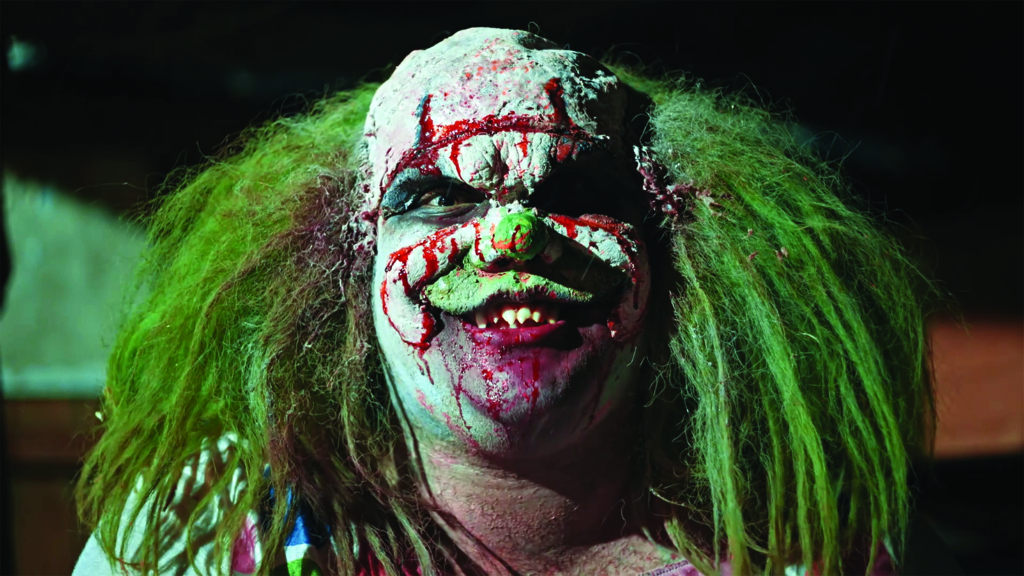
Bearing on the past
It’s not just the Spookers employees who have navigated difficult histories. The Kingseat Psychiatric Hospital, officially closed in 1999 following sweeping reforms to New Zealand’s mental-health system, has seen multiple claims of former patients of having been subjected to abuse.[4]Martin Johnston, ‘Police Re-open Boy’s Hospital Death Case After 36 Years’, The New Zealand Herald, 12 June 2004, <http://www.nzherald.co.nz/nz/news/article.cfm?c_id=1&objectid=3572191>, accessed 7 November 2017. Habicht reached out to former Kingseat staff, including a nurse interviewed on camera who’s a little bemused by the building’s new life as an amusement park. He also encountered Debra Lampshire, who spent eighteen years institutionalised there as a young woman. She is now an internationally renowned expert in mental-health research, support and education at the University of Auckland.
Lampshire has disclosed her concerns that the haunted-house antics of Spookers propagate stigma, enforcing harmful stereotypes surrounding mental illness.[5]See Jeremy Olds, ‘From Hospital to Haunted House: Former Patients Criticise Spookers’, Stuff.co.nz, 5 October 2017, <https://www.stuff.co.nz/life-style/well-good/97459954/from-hospital-to-haunted-house-former-patients-criticise-spookers>, accessed 7 November 2017. Her heartfelt, intelligent argument provides a fascinating counterpoint to the positive psychological support experienced by Borkent, Apiata and co., according to Habicht.
The most moving stuff was with Debra. The stuff she told me, I just could never get out of my head. She’s amazing. I’ve got two hours of her and you could put that in a cinema and it would be utterly compelling.
While, by the time of our interview, Florian hadn’t had a chance to sit down and watch the film together with Lampshire, he hopes that they can some day soon. He wonders if perhaps, by listening to the Spookers employees’ stories, Lampshire may come to see some worth in what they are doing there, even if she does not fully agree with their methods.
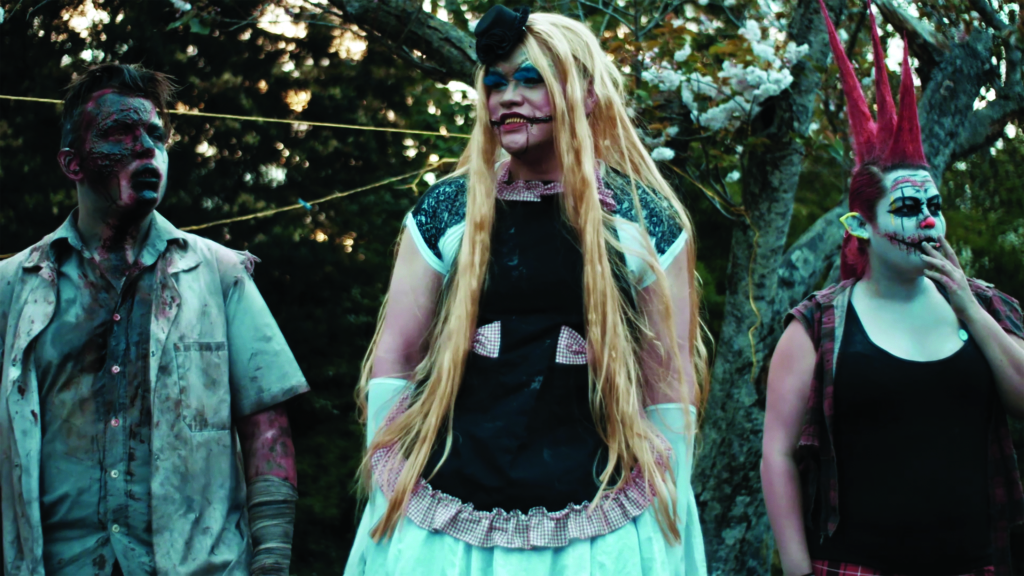
Spookers doesn’t hide from the spectre of this fraught narrative. Indeed, Habicht tackles it directly, asking several performers whether they had pondered over the possible harmful consequences of their performances on the wellbeing of previous patients.
It’s interesting because most of the females play psychiatrically disturbed characters and, to me, it looked like it was a reference to the history of the place. But most of them get their inspiration from Hollywood – they love horror films, so they weren’t consciously re-enacting history.
Habicht detects, in these interviews, a naivety that he himself once possessed. Connecting with Lampshire and benefiting from her extensive insights took the documentary down an alternative route that he had not previously envisaged. As a filmmaker, he relishes these unexpected turns, and is always prompting himself to engage with ethical considerations. Yet Habicht is adamant that what he saw at Spookers is driven by the best of intentions, and argues that it is important to explore material in documentaries that can be seen as uncomfortable.
Recognising kindred spirits in Spookers’ strange yet happy family, Habicht draws parallels between his avowedly alternative approach to filmmaking and the boldness that, for many of the actors, asserted itself far earlier than in his own art-school awakening. He doubts he could have been as brave at their age.
I’d give them a medal. The thing I have learned most from making films is that honesty is the most important thing, and people can smell bullshit. My films are all contrived or fantastical, but I try to come from a really honest place. These guys, what they contributed to the film, they got that from the word go.
http://www.florianhabicht.com/
Endnotes
| 1 | Liebesträume, Vimeo, 3 March 2012, <https://vimeo.com/37851376>, accessed 7 November 2017. |
|---|---|
| 2 | Philip Matthews, ‘Fast, Cheap and Out of Control: Three Films from New Zealand’s Digital Video “Revolution”’, Senses of Cinema, issue 31, April 2004, <http://sensesofcinema.com/2004/feature-articles/nz_digital_revolution/>, accessed 7 November 2017. |
| 3 | Florian Habicht, in Clare O’Leary, ‘Florian Habicht: A Filmmaker with a Light and Quirky Touch…’, NZ On Screen website, 2008, <https://www.nzonscreen.com/interviews/interview-with-florian-habicht/overview>, accessed 7 November 2017. |
| 4 | Martin Johnston, ‘Police Re-open Boy’s Hospital Death Case After 36 Years’, The New Zealand Herald, 12 June 2004, <http://www.nzherald.co.nz/nz/news/article.cfm?c_id=1&objectid=3572191>, accessed 7 November 2017. |
| 5 | See Jeremy Olds, ‘From Hospital to Haunted House: Former Patients Criticise Spookers’, Stuff.co.nz, 5 October 2017, <https://www.stuff.co.nz/life-style/well-good/97459954/from-hospital-to-haunted-house-former-patients-criticise-spookers>, accessed 7 November 2017. |
